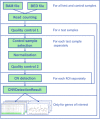panelcn.MOPS: Copy-number detection in targeted NGS panel data for clinical diagnostics
- PMID: 28449315
- PMCID: PMC5518446
- DOI: 10.1002/humu.23237
panelcn.MOPS: Copy-number detection in targeted NGS panel data for clinical diagnostics
Abstract
Targeted next-generation-sequencing (NGS) panels have largely replaced Sanger sequencing in clinical diagnostics. They allow for the detection of copy-number variations (CNVs) in addition to single-nucleotide variants and small insertions/deletions. However, existing computational CNV detection methods have shortcomings regarding accuracy, quality control (QC), incidental findings, and user-friendliness. We developed panelcn.MOPS, a novel pipeline for detecting CNVs in targeted NGS panel data. Using data from 180 samples, we compared panelcn.MOPS with five state-of-the-art methods. With panelcn.MOPS leading the field, most methods achieved comparably high accuracy. panelcn.MOPS reliably detected CNVs ranging in size from part of a region of interest (ROI), to whole genes, which may comprise all ROIs investigated in a given sample. The latter is enabled by analyzing reads from all ROIs of the panel, but presenting results exclusively for user-selected genes, thus avoiding incidental findings. Additionally, panelcn.MOPS offers QC criteria not only for samples, but also for individual ROIs within a sample, which increases the confidence in called CNVs. panelcn.MOPS is freely available both as R package and standalone software with graphical user interface that is easy to use for clinical geneticists without any programming experience. panelcn.MOPS combines high sensitivity and specificity with user-friendliness rendering it highly suitable for routine clinical diagnostics.
Keywords: clinical diagnostics; copy-number variation; deletion; duplication; panel sequencing; targeted next-generation sequencing.
© 2017 The Authors. Human Mutation published by Wiley Periodicals, Inc.
Figures



Similar articles
-
Evaluation of CNV detection tools for NGS panel data in genetic diagnostics.Eur J Hum Genet. 2020 Dec;28(12):1645-1655. doi: 10.1038/s41431-020-0675-z. Epub 2020 Jun 19. Eur J Hum Genet. 2020. PMID: 32561899 Free PMC article.
-
Evaluating the Calling Performance of a Rare Disease NGS Panel for Single Nucleotide and Copy Number Variants.Mol Diagn Ther. 2017 Jun;21(3):303-313. doi: 10.1007/s40291-017-0268-x. Mol Diagn Ther. 2017. PMID: 28290094
-
cn.MOPS: mixture of Poissons for discovering copy number variations in next-generation sequencing data with a low false discovery rate.Nucleic Acids Res. 2012 May;40(9):e69. doi: 10.1093/nar/gks003. Epub 2012 Feb 1. Nucleic Acids Res. 2012. PMID: 22302147 Free PMC article.
-
Free-access copy-number variant detection tools for targeted next-generation sequencing data.Mutat Res Rev Mutat Res. 2019 Jan-Mar;779:114-125. doi: 10.1016/j.mrrev.2019.02.005. Epub 2019 Feb 23. Mutat Res Rev Mutat Res. 2019. PMID: 31097148 Review.
-
Detection of structural DNA variation from next generation sequencing data: a review of informatic approaches.Cancer Genet. 2013 Dec;206(12):432-40. doi: 10.1016/j.cancergen.2013.11.002. Epub 2013 Nov 20. Cancer Genet. 2013. PMID: 24405614 Free PMC article. Review.
Cited by
-
Parkinson's Disease Gene Screening in Familial Cases from Central and South America.Mov Disord. 2024 Oct;39(10):1843-1855. doi: 10.1002/mds.29931. Epub 2024 Jul 25. Mov Disord. 2024. PMID: 39051491
-
Next-Generation Sequencing-Based Copy Number Variation Analysis in Chinese Patients with Primary Ciliary Dyskinesia Revealed Novel DNAH5 Copy Number Variations.Phenomics. 2024 Feb 22;4(1):24-33. doi: 10.1007/s43657-023-00130-0. eCollection 2024 Feb. Phenomics. 2024. PMID: 38605905 Free PMC article.
-
Bioinformatics of germline variant discovery for rare disease diagnostics: current approaches and remaining challenges.Brief Bioinform. 2024 Jan 22;25(2):bbad508. doi: 10.1093/bib/bbad508. Brief Bioinform. 2024. PMID: 38271481 Free PMC article. Review.
-
BRACNAC: A BRCA1 and BRCA2 Copy Number Alteration Caller from Next-Generation Sequencing Data.Int J Mol Sci. 2023 Nov 22;24(23):16630. doi: 10.3390/ijms242316630. Int J Mol Sci. 2023. PMID: 38068953 Free PMC article.
-
Early Cancer Detection in Li-Fraumeni Syndrome with Cell-Free DNA.Cancer Discov. 2024 Jan 12;14(1):104-119. doi: 10.1158/2159-8290.CD-23-0456. Cancer Discov. 2024. PMID: 37874259 Free PMC article.
References
-
- Chang, W. , Cheng, J. , Allaire, J. J. , Xie, Y. , & McPherson, J. (2016). Shiny: Web application framework for R. Retrieved from https://CRAN.R-project.org/package=shiny
-
- Charbonnier, F. , Raux, G. , Wang, Q. , Drouot, N. , Cordier, F. , Limacher, J. , … Frebourg, T. (2000). Detection of exon deletions and duplications of the mismatch repair genes in hereditary nonpolyposis colorectal cancer families using multiplex polymerase Chain Reaction of Short Fluorescent Fragments. Cancer Research, 60, 2760–2763. - PubMed
Publication types
MeSH terms
LinkOut - more resources
Full Text Sources
Other Literature Sources

